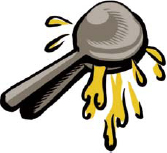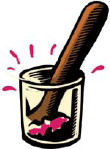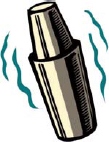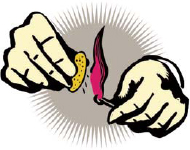 TECHNIQUES
TECHNIQUES 
There are a handful of contemporary cocktail manuals that delve more deeply into elemental cocktail preparation that are listed in The Bartender's Library. Studying the techniques expounded upon in these guides is suggested, but not required, to prepare the recipes collected in this book. To conserve space, the mixing instructions below each recipe have been truncated. I’ve compiled detailed instructions below to follow when preparing drinks from this book.
Preparing the Glass
Clean and polish glassware before service.
Glassware is chilled in a freezer, with ice, or preheated with hot water (for warm drinks), before a recipe is prepared.
Cocktails requiring sugar or spice rims are rimmed first and chilled afterward.
All stems should be prepared and placed in front of the bartender before a drink is shaken, stirred, or heated.
Mixing and Pouring
We pour the smaller, less expensive quantities specified in a recipe in ascending order concluding with the base spirit.
All the ingredients are poured into shakers or mixing glasses without ice. After all the drinks in a round are built, ice is added and the drinks are shaken, stirred, or heated. This allows the bartender to prepare many drinks at the same time so they can be served together.
We rinse glassware with an atomizer, instead of pouring, to evenly coat the glass and reduce waste.

The quantity of sparkling ingredient has been specified in each recipe that requires it. Filling the glass to the brim after shaking or stirring is less important than achieving the proper balance.
Muddling
Herbs should be cleaned and sorted before muddling. Good-looking leaves should be reserved for garnish, and less appealing specimens can be used for muddling as long as they’re not bruised or discolored.
Herbs, spices, and fruits should be muddled with approximately .75 ounce of liquid, typically simple syrup or a liqueur called for in the recipe.

Muddling is much closer to pressing than pulverizing; the goal is to gently extract essential oils and juices.
Shaking
Our drinks are shaken or stirred with approximately 10–12 cubic ounces of 1.25" ice cubes for 8–12 seconds. With smaller cubes, the preparation time and amount of ice required to properly chill and dilute cocktails may vary.
Drinks prepared with citrus, cream, eggs, or muddled ingredients are traditionally shaken.

Cocktails requiring eggs are shaken for 5–7 seconds without ice to emulsify the egg proteins, then shaken with ice for 10–13 seconds to dilute and chill the mixture.
Stirring
Stirred drinks, typically composed exclusively of spiritous ingredients, are prepared in a chilled mixing glass with a spout. We stir gently, so no air bubbles are formed, for 10–13 seconds.
When mixing with large ice cubes, it’s advisable to combine cracked ice with blocks to achieve proper dilution.
Cocktails built or poured, then topped with sparkling ingredients, require a gentle stir to integrate the liquid.
Straining
As soon as a drink is thoroughly mixed and chilled or heated, it should be strained or poured into a prepared glass.
Drinks should be strained over fresh ice unless pouring unstrained is specified.
Shaken cocktails are strained from the large metal half of the Boston shaker with a Hawthorne strainer. Stirred cocktails are strained from the mixing glass with a julep strainer.
Small pieces of muddled herbs, spices, and fruit are typically fine-strained by pouring the liquid through both a julep or Hawthorne strainer and a fine strainer, held above the cocktail glass. Ice shards may also be fine-strained if clarity with no further dilution is preferred.
Citrus Twists
Citrus twists have the dual purpose of providing an aromatic garnish (the essential oil released when you pinch a twist skin-side down over the surface of the drink) and aesthetics.
We use quarter-sized discs that are cut with a small portion of pith left to provide structure. We pinch the disc skin-side down over the center of the liquid, rub the peel skin-side down around the circumference of the glass, and drop it in the drink skin-side up.
Flaming a twist refers to holding a lit match between the twist and surface of the cocktail. When the peel comes in contact with a match, it makes the oil (and the cocktail) taste like sulfur, so we are very careful to not let the peel touch the flame’s source.

Fruit Slices, Berries, Citrus Wedges, Wheels, and Half Wheels
Fruits such as apples and pears may be sliced and affixed to the glass or arranged in a fan held together with a cocktail pick.
Watermelon, honeydew, or cantaloupe is typically scooped with a melon baller and impaled with a cocktail pick. Berries such as blueberries, raspberries, and blackberries may also be attached with a pick.
A citrus wedge garnish, in cocktails such as a gin and tonic, is affixed to the rim of the glass with a small slit in the middle of the meat. All citrus should be seeded before service.
A citrus wheel or half wheel is purely ornamental. Lemons and limes are cut paper-thin and either floated on the surface of the drink or cut a little thicker with a radial slit allowing it to be affixed to the rim of the glass.
Larger citrus fruits such as grapefruits or oranges should be cut into halfwheels to bend around the rim of the glass.
Other Garnishes
Spices or citrus peel are grated fresh over a finished cocktail with either a citrus zester or a spice grater: roughly 1/16 of a teaspoon of spice is added, and no more than a 1/8 teaspoon of grated citrus peel.
Brushing a sprig or herb’s leaf against the back of your hand or giving it a gentle clap before placing it in the drink releases its essential oils, providing a pleasant aromatic cloud around the drink.
Atomizers are used for aromatic garnishes. We cover the back and sides of the glass with our free hand to ensure the liquid sprayed over the surface of the cocktail remains in the glass.
Cherries, olives or onions (always 3) are affixed to a cocktail pick: we use 4" bamboo skewers.